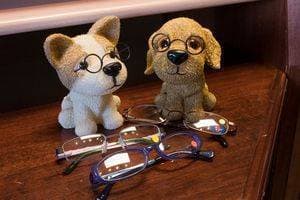These are the 12 most frequent questions asked to vision therapy eye doctors on lazy eye.
You may easily find answers to your questions below. If you still have questions, contact your nearest eye doctor experienced in children’s vision and vision therapy.
Q1: What is a lazy eye?
A: Lazy eye is medically termed Amblyopia, is a neuro-developmental vision condition that develops when one eye is unable to achieve normal visual acuity or does not allow the full development of stereopsis (3D vision).
Q2: How does a lazy eye affect vision?
A: A lazy eye typically affects the vision or visual function of the affected eye, causing blurry vision even with corrective eyewear. The condition also commonly presents with reduced visual skills, poor depth perception, and reading difficulties.
Q3: How common is lazy eye?
A: According to research, amblyopia affects up to 1 in 33 of the U.S. population— this means up to 10 million children and adults may have a lazy eye.
While the condition typically presents in early childhood, a lazy eye can develop later on in life as well.
Q4: What causes a lazy eye?
A: The true underlying cause of lazy eye is a reaction in the brain, called suppression. Suppression occurs when the brain actively ignores some or all of the visual information coming from one eye to avoid blurry or double vision (diplopia) or ocular discomfort. Suppression can cause serious consequences, and can lead to an eye turn, also known as strabismus.
Q5: Who is at risk of developing a lazy eye?
- Premature birth
- Small birth weight
- Family history of lazy eye
- Developmental delays
Q6: Which vision conditions can cause a lazy eye?
A: Lazy eye can develop from a few different vision conditions:
- Refractive amblyopia is the most common form of amblyopia. It can be divided into two types:
- Isometropia is a significantly high, but equal optical prescription in both eyes.
- Anisometropia is a significant difference in eyeglass prescription (i.e. nearsightedness, farsightedness, astigmatism) between the two eyes.
- Constant strabismus is a constant noticeable turn of one eye in any direction. An inward turn of the eye (esotropia) is the most common. Amblyopia resulting from strabismus can be easier to detect because the noticeable eye turn alerts to a vision problem.
- Ocular obstruction can result from any physical blockage of vision, such as a cataract, trauma, lid droop (ptosis), or blocked tear duct.
Congenital disorders and vitamin A deficiency are less common causes of lazy eye.
Q7: How do I know if my child has a lazy eye?
A: Parents often have a difficult time recognizing a lazy eye because the condition usually develops in one eye, and may not present with a noticeable eye turn. Also, children generally learn how to ignore the lazy eye and compensate by mainly relying on the sight from the ‘good’ eye.
If your child presents with any of the following symptoms, they may have a lazy eye:
- Shutting one eye or squinting
- Rubbing eyes often
- Poor eye-hand coordination
- Tripping often or accident prone
- Poor depth perception
- Difficulty with fine eye movements
- Reduced reading speed and comprehension
- Poor eye focusing skills, or inability to follow an object with just the eyes
- A cross-eyed appearance
- Unusual eye movements such as flickering or blinking
Q8: How is a lazy eye diagnosed?
A: Specific tests are used during eye exams to assess both the visual acuity, depth perception and the visual skills of each eye— enabling your doctor to diagnose a condition such as lazy eye. Tests of visual skills allow your doctor to assess how well each eye is performing individually, and identify an effective eye-brain connection.
Find an eye doctor near you that has experience in diagnosing and treating lazy eyes.
SEE RELATED: 7 Signs Your Child Might Have a Lazy Eye
Q9: How is the lazy eye treated?
A: Lazy eye can be treated through different means— depending on the type, severity, and age of the patient. A variety of treatment options have been shown to strengthen the eye-brain connection necessary for improved binocular vision.
Corrective eyewear is prescribed to ensure that each eye has the highest visual acuity possible. According to the Pediatric Eye Disease Investigator Group (PEDIG) research, 77 percent of children with refractive amblyopia showed improved vision acuity within fifteen weeks of wearing corrective eyeglasses.
However, the eyeglasses alone do not treat the underlying problem. Therefore, a treatment program of vision therapy is usually prescribed to retrain the eye-brain connections of the lazy eye.
Q10: How can vision therapy treat a lazy eye?
A: Vision therapy has been shown to greatly improve the visual skills of the lazy eye by re-training the visual system and strengthening the neural communication between the lazy eye and the brain. Through vision therapy, the two eyes will be trained to work together to achieve clear and comfortable binocular vision.
A vision therapy program to treat lazy eye may include activities that focus on improving the following skills:
- Accommodation (focusing)
- Fixation (visual gaze)
- Saccades (eye jumps)
- Pursuits (eye tracking)
- Convergence (binocular vision)
- Spatial skills (eye-hand coordination)
- Stereopsis (3-D vision)
Q11: How does eye patching work?
A: Eye patching is usually recommended together with a vision therapy program. An eye patch is placed over the stronger eye— forcing the lazy eye to work and develop stronger neural connections to the brain. Vision is recovered as the brain begins to acknowledge and process visual signals coming from the lazy eye.
Q12: How long will my child need to wear an eye patch?
A: This will be determined by the extent of the lazy eye. Recent research conducted by the PEDIG team has proven that eye patching for a moderate lazy eye is effective when worn for only two hours per day with one hour of near vision exercises. The research revealed that:
- 62% of patients that patched for two hours per day showed improved visual acuity within about four months of treatment.
If your child is showing signs of a lazy eye, or any other vision problem, schedule an eye exam for a comprehensive assessment of your child’s vision and ocular health.
Discuss any concerns you may have with your eye doctor— the earlier a vision problem is detected, the sooner your child will be able to achieve clear and comfortable vision.
LEARN MORE: Guide to Vision Therapy for Lazy Eye
Schedule an eye exam with an eye doctor near you to assess your child’s vision so they can see clearly and comfortably.










